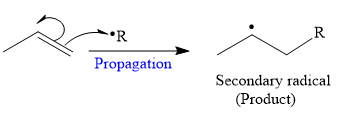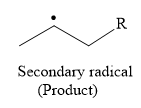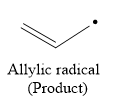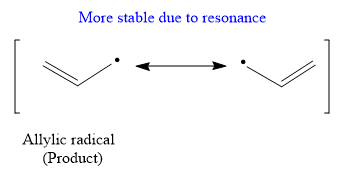
(a)
Interpretation:
Propylene does not undergo free radical
Concept introduction:
In any free radical polymerization reaction generally, three steps are involved viz. initiation, propagation, and termination. In initiation step, free radicals are generated from either monomer or from another compound such as hydrogen peroxide or benzoyl peroxide called a radical initiator. In propagation, step radicals react with the monomer to grow the chain to build up ![]() ) is used to represents the movement of a single electron in a homolysis process.
) is used to represents the movement of a single electron in a homolysis process.
Answer to Problem 26.37P
Propylene does not undergo free radical polymerization readily because there are two competing steps after initiation: propagation and hydrogen atom abstraction. The mechanism and products for these two competing steps are given below:


Explanation of Solution
The mechanism for the propagation and its corresponding product for a given reaction is shown below:

So in the propagation step, secondary radical is formed as a product.

The mechanism for the hydrogen atom abstraction and its corresponding product in a given reaction is shown below:

So in the hydrogen atom abstraction step, allylic radical is formed as a product.

Propylene does not undergo free radical polymerization readily because there are two competing steps after initiation: propagation and hydrogen atom abstraction. The mechanism and products for these two competing steps are drawn.
(b)
Interpretation:
Propylene does not undergo free radical polymerization readily because there are two competing steps after initiation: propagation and hydrogen atom abstraction. It is to be explained which step produces a more stable product.
Concept introduction:
In any free radical polymerization reaction generally, three steps are involved viz. initiation, propagation, and termination. In initiation step, free radicals are generated from either monomer or from another compound such as hydrogen peroxide or benzoyl peroxide called a radical initiator. In propagation, step radicals react with the monomer to grow the chain to build up polymer and this process is called a chain-growth polymerization or addition polymerization. Finally, in terminating step, the growth of polymer is stopped by two ways: combination or disproportionation. In combination step, two growing polymer radicals combine to form the uncharged product, polymer. The termination occurs when the one radical abstracts a hydrogen atom from another radical is called disproportionation. The breaking of a covalent bond, whereby the electrons making up that bond are distributed equally to the atoms which are disconnected is known as the homolytic bond dissociation or homolysis. So in homolysis generally radicals are formed. In homolysis, a covalent bond is a breakdown equally and each atom acquires a single electron which is called a radical and a single barbed arrow (![]() ) is used to represents the movement of a single electron in a homolysis process. The weakest bond possesses the smallest
) is used to represents the movement of a single electron in a homolysis process. The weakest bond possesses the smallest
Answer to Problem 26.37P
Due to resonance stabilization, an allylic radical is more stable than the secondary radical.
Explanation of Solution
The products of both these steps are:


The stability order of the radical is

Propylene does not undergo free radical polymerization readily because there are two competing steps after initiation: propagation and hydrogen atom abstraction. It is explained which step produce a more stable product on the basis of the stability of radicals.
(c)
Interpretation:
Propylene does not undergo free radical polymerization readily because there are two competing steps after initiation: propagation and hydrogen atom abstraction. It is to be explained why propylene is poor reactive in free radical polymerization.
Concept introduction:
In any free radical polymerization reaction generally, three steps are involved viz. initiation, propagation, and termination. In initiation step, free radicals are generated from either monomer or from another compound such as hydrogen peroxide or benzoyl peroxide called a radical initiator. In propagation, step radicals react with the monomer to grow the chain to build up polymer and this process is called a chain-growth polymerization or addition polymerization. In a such case for propagation step less stable radical must be formed. Finally, in terminating step, the growth of polymer is stopped by two ways: combination or disproportionation. In combination step, two growing polymer radicals combine to form the uncharged product, polymer. The termination occurs when the one radical abstracts a hydrogen atom from another radical is called disproportionation. The breaking of a covalent bond, whereby the electrons making up that bond are distributed equally to the atoms which are disconnected is known as the homolytic bond dissociation or homolysis. So in homolysis generally radicals are formed. In homolysis, a covalent bond is a breakdown equally and each atom acquires a single electron which is called a radical and a single barbed arrow (![]() ) is used to represents the movement of a single electron in a homolysis process. The weakest bond possesses the smallest bond dissociation energy. The stability order for radicals is
) is used to represents the movement of a single electron in a homolysis process. The weakest bond possesses the smallest bond dissociation energy. The stability order for radicals is
Answer to Problem 26.37P
In free radical polymerization reaction less stable radical must be formed to propagate the chain. But in given case more stable, allylic carbocation is formed which affects the propagation step results in rate of polymerisation is very low.
Explanation of Solution
The products of the both steps in free radical polymerization of propylene are given below:


Due to the formation of more stable, allylic radical in hydrogen atom abstraction step it will interfere with the formation of polymer.

In free radical polymerization reaction less stable radical must be formed to propagate the chain. But in given case more stable, allylic carbocation is formed which affects the propagation step results in rate of polymerisation is very low.
Propylene does not undergo free radical polymerization readily because there are two competing steps after initiation: propagation and hydrogen atom abstraction. It is explained why propylene is poor reactive in free radical polymerization.
Want to see more full solutions like this?
Chapter 26 Solutions
Organic Chemistry: Principles and Mechanisms (Second Edition)
- One method for the analysis of Fe3+, which is used with a variety of sample matrices, is to form the highly colored Fe3+–thioglycolic acid complex. The complex absorbs strongly at 535 nm. Standardizing the method is accomplished using external standards. A 10.00-ppm Fe3+ working standard is prepared by transferring a 10-mL aliquot of a 100.0 ppm stock solution of Fe3+ to a 100-mL volumetric flask and diluting to volume. Calibration standards of 1.00, 2.00, 3.00, 4.00, and 5.00 ppm are prepared by transferring appropriate amounts of the 10.0 ppm working solution into separate 50-mL volumetric flasks, each of which contains 5 mL of thioglycolic acid, 2 mL of 20% w/v ammonium citrate, and 5 mL of 0.22 M NH3. After diluting to volume and mixing, the absorbances of the external standards are measured against an appropriate blank. Samples are prepared for analysis by taking a portion known to contain approximately 0.1 g of Fe3+, dissolving it in a minimum amount of HNO3, and diluting to…arrow_forwardAbsorbance and transmittance are related by: A = -log(T) A solution has a transmittance of 35% in a 1-cm-pathlength cell at a certain wavelength. Calculate the transmittance if you dilute 25.0 mL of the solution to 50.0 mL? (A = εbc) What is the transmittance of the original solution if the pathlength is increased to 10 cm?arrow_forwardUnder what conditions will Beer’s Law most likely NO LONGER be linear? When the absorbing species is very dilute. When the absorbing species participates in a concentration-dependent equilibrium. When the solution being studied contains a mixture of ions.arrow_forward
- Compared to incident (exciting) radiation, fluorescence emission will have a: Higher energy Higher frequency Longer wavelengtharrow_forwardLin and Brown described a quantitative method for methanol based on its effect on the visible spectrum of methylene blue. In the absence of methanol, methylene blue has two prominent absorption bands at 610 nm and 663 nm, which correspond to the monomer and the dimer, respectively. In the presence of methanol, the intensity of the dimer’s absorption band decreases, while that for the monomer increases. For concentrations of methanol between 0 and 30% v/v, the ratio of the two absorbance, A663/ A610, is a linear function of the amount of methanol. Use the following standardization data to determine the %v/v methanol in a sample if A610 is 0.75 and A663 is 1.07.arrow_forwardThe crystal field splitting energy, Δ, of a complex is determined to be 2.9 × 10-19 What wavelength of light would this complex absorb? What color of light is this? What color would the compound be in solution?arrow_forward
- A key component of a monochromator is the exit slit. As the exit slit is narrowed, the bandwidth of light (i.e., the range of wavelengths) exiting the slit gets smaller, leading to higher resolution. What is a possible disadvantage of narrowing the exit slit? (Hint: why might a narrower slit lower the sensitivity of the measurement?).arrow_forwardAn x-ray has a frequency of 3.33 × 1018 What is the wavelength of this light?arrow_forwardChoose the Lewis structure for the compound below: H2CCHOCH2CH(CH3)2 HH H :d H H H C. Η H H HH H H H H. H H H HH H H H H H- H H H C-H H H HHHHarrow_forward
- Each of the highlighted carbon atoms is connected to hydrogen atoms.arrow_forwardく Complete the reaction in the drawing area below by adding the major products to the right-hand side. If there won't be any products, because nothing will happen under these reaction conditions, check the box under the drawing area instead. Note: if the products contain one or more pairs of enantiomers, don't worry about drawing each enantiomer with dash and wedge bonds. Just draw one molecule to represent each pair of enantiomers, using line bonds at the chiral center. More... No reaction. Explanation Check O + G 1. Na O Me Click and drag to start drawing a structure. 2. H + 2025 McGraw Hill LLC. All Rights Reserved. Terms of Use | Privacy Center | Accessibility 000 Ar Parrow_forwardDraw a tetramer of this alternating copolymer.arrow_forward
 ChemistryChemistryISBN:9781305957404Author:Steven S. Zumdahl, Susan A. Zumdahl, Donald J. DeCostePublisher:Cengage Learning
ChemistryChemistryISBN:9781305957404Author:Steven S. Zumdahl, Susan A. Zumdahl, Donald J. DeCostePublisher:Cengage Learning ChemistryChemistryISBN:9781259911156Author:Raymond Chang Dr., Jason Overby ProfessorPublisher:McGraw-Hill Education
ChemistryChemistryISBN:9781259911156Author:Raymond Chang Dr., Jason Overby ProfessorPublisher:McGraw-Hill Education Principles of Instrumental AnalysisChemistryISBN:9781305577213Author:Douglas A. Skoog, F. James Holler, Stanley R. CrouchPublisher:Cengage Learning
Principles of Instrumental AnalysisChemistryISBN:9781305577213Author:Douglas A. Skoog, F. James Holler, Stanley R. CrouchPublisher:Cengage Learning Organic ChemistryChemistryISBN:9780078021558Author:Janice Gorzynski Smith Dr.Publisher:McGraw-Hill Education
Organic ChemistryChemistryISBN:9780078021558Author:Janice Gorzynski Smith Dr.Publisher:McGraw-Hill Education Chemistry: Principles and ReactionsChemistryISBN:9781305079373Author:William L. Masterton, Cecile N. HurleyPublisher:Cengage Learning
Chemistry: Principles and ReactionsChemistryISBN:9781305079373Author:William L. Masterton, Cecile N. HurleyPublisher:Cengage Learning Elementary Principles of Chemical Processes, Bind...ChemistryISBN:9781118431221Author:Richard M. Felder, Ronald W. Rousseau, Lisa G. BullardPublisher:WILEY
Elementary Principles of Chemical Processes, Bind...ChemistryISBN:9781118431221Author:Richard M. Felder, Ronald W. Rousseau, Lisa G. BullardPublisher:WILEY





